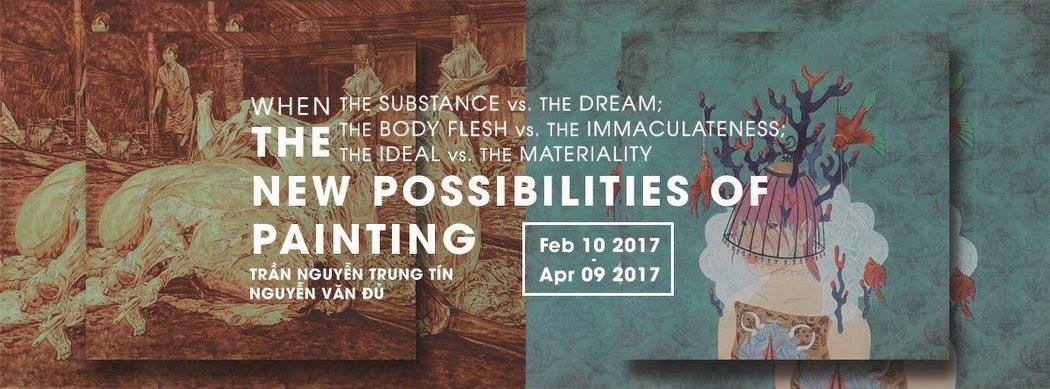Organizer: The Factory Contemporary Arts Centre and Nguyễn Như Huy
Curator: Nguyễn Như Huy
Location: The Factory, no.15 Nguyen U Di str, Thao Dien ward, District 2, Ho chi Minh city, Vietnam
Time & date: Feb-10-2017 - Apr-09-2017
An excerpt from the curatorial essay of Nguyễn Như Huy:
Nguyễn Văn Đủ (b. 1986) and Trần Nguyễn Trung Tín (b. 1992) are representative of the youngest generation of Vietnamese artists practicing painting today. They treat their paintings in a more calm and peaceful manner than prior generations, as they consider their artworks a natural instrument for expression, not just a weapon/tool in the war between modernity and tradition, between what is local and global.
… Tín and Đủ have many contrasts between them. These contrasts lie not only in their ideas or the contents of their paintings, but also in the materials they use. By these contrasts, they show that paintings is not a medium to be decentralized with the emergence of new multimedia art materials, but is in fact a very rich area of possibility to collaborate with other ideas and instruments. Curator of this exhibition, Nguyễn Như Huy, thus seeks to find a way to reveal the artistic expression of paintings at the time when, seemingly, there is a resurrection of drawing in Vietnam in the first years of the 21st century.
A. Nguyễn Văn Đủ: materiality, flesh, purification, non-fiction and the conversation with the history of arts.
…All 6 paintings illustrate the scenes of a slaughterhouse. Full of shades of red, these paintings erase the borders between illustration and its object, immediately bringing the audience into a space raising feelings of disgust, due to the referred material of blood. At the same time however, thanks to the adept realistic illustrating ability of the artist, there is also disinterestedness, or in other words, ‘beautifulness’ (as philosopher Immanuel would characterize).
Đủ’s paintings are also in conversation with several directions in the history of world arts. Seeing the body of butchered cows in Đủ’s paintings is similar to having a conversation with Chaim Soutine’s sticky cows; with Andre Serrano’s decollated cow head; with half-body cows lain in a formaldehyde pool in the work of Damien Hirst. Because of this history, Đủ’s artworks become a part of a common aesthetic interest. On another hand, due to the religious aspect (artist quit eating meat when producing this work), the paintings go further than aesthetic history to become an act of religious mortification…
…By this manner, Du opens a new and interesting ability of paintings in Vietnam: the mix of reality and fiction, objects and the drawing of that object, religious practice in aesthetic space.
B. Trần Nguyễn Trung Tín: fiction, multi-traditional world, immateriality and non-nationality of paintings
Silk paintings in Vietnam, until before the last decade, possessed narratives considered to be old, simple, mild, floral or feminine or, literately or figuratively, related to East Asia, to Vietnam, to something which is ‘natural’ and not modern.
Tín is not the first to utilize the traditional narrative method about silk. In terms of this manner, there is artist Bùi Tiến Tuấn, with the images of women in modern fashion; painter Vũ Đình Tuấn with decorative images in urban life; recently there is Lê Thúy who paints silk paintings without coloring its background, using realistic illustrating technique to show skeletons or nude women. All of them use silk as a material possessing a narrative typically considered characteristic of Vietnam.
In Tín’s artistic practice, we can see countless influence from other traditional factors beyond Vietnam mixed with each other: from animation, Japanese illustration to writer Hermann Broch. Tín’s art, therefore, did not start just from Vietnamese narratives but also from the modern world. In some angles, it creates a different kind of tradition, a kind of East Asia, a kind of Vietnam in which future and past mix with each other, with We and Them, as fiction and non-fiction.
Even more extremeness, Tín’s paintings go beyond drawing. 9 paintings are the portraits of 9 fictional characters that Tín created. the work will be accompanied by a soundscape, created separatedly (2 soundscapes) by musician Tôn Thất An and Do Tan Si, just for Tín.
Beauté-Faux Project:
By reimagining my past events and dreamscapes as visual impersonal imagery and sounds, the project is my practice to question and reconsider my own memmories and thoughts as your mind sometimes tends to make up unreal memories, so real that you actually thought they did happen. Then hopefully be able to answer the question of my identity. The project also view the frustration of how people feel easier to processed ugly truths clipped with beautiful images.
The concept of layers will be exploited through the whole project as a tool of analyzing and interpretating the subjects to put them into perspective.
Silk paintings: there will be 9 multilayer silk paintings.
I believe in the narration power of visual and sound. So with each piece of painting there will be a soundtrack to help emphasize the feeling of the work. The 9 soundtrack are 9 layers that when put together will create a harmonic melody implying that all the paintings although created and viewed independently are constructive elements to reflex a vision that is my identity.
more about the project here

